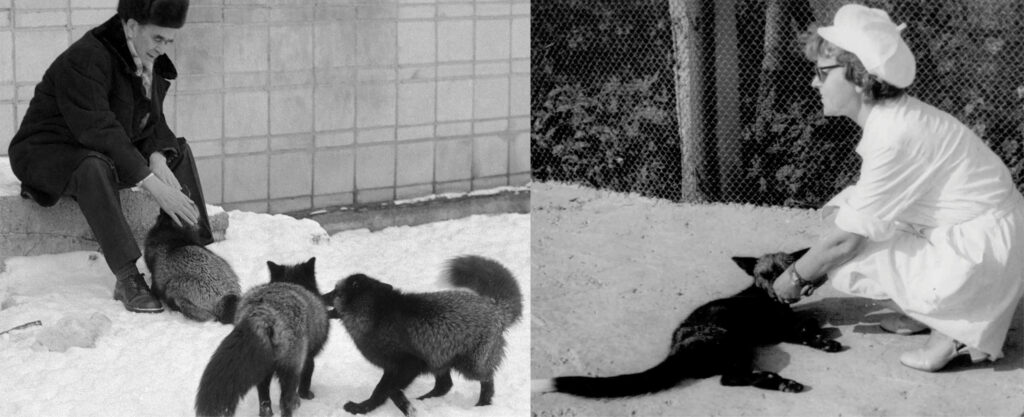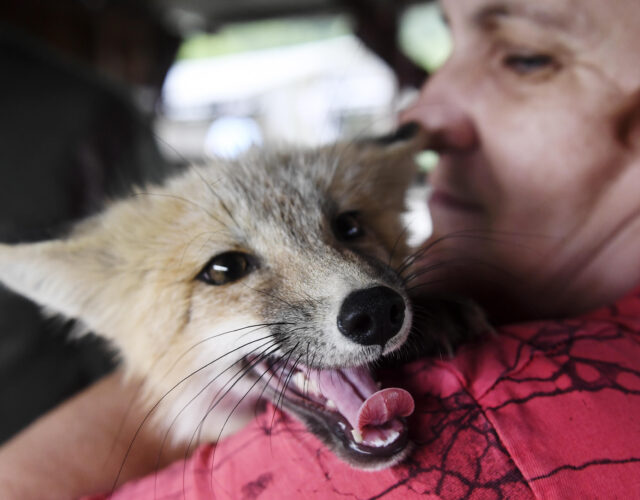Lee Alan Dugatkin and Lyudmila Trut. How to Tame a Fox (and Build a Dog): Visionary Scientists and a Siberian Tale of Jump-Started Evolution. University of Chicago Press, 2017. 216 pp. $26.
I looked away from my dog-training book to study the little, black-and-white mottled body resting quietly at my feet. Good boy, Smokey. Then I remembered the earlier growl and snap at a visiting friend. Oh, boy, Smokey. Admittedly, I’d brought home the Australian cattle dog–beagle mix just three days earlier, but having never owned a shelter pup, I wondered if I’d bitten off more chew toy than either of us could manage.
The same week I was reading about the inner workings of Smokey’s brain and approaches to dog training, How to Tame a Fox (and Build a Dog) crossed my desk. This short book describes Soviet scientists’ efforts to domesticate Siberian silver foxes, and I wondered if it could help me rebuild, so to speak, my shelter pup, who was exhibiting a lot of anxiety. At the very least it promised insight into how humans and dogs came to their remarkable relationship.
The book was written by Lee Alan Dugatkin, an American evolutionary biologist and historian of science, and Lyudmila Trut, a Russian professor of evolutionary genetics and the lead researcher on the domestication experiment. Interwoven with descriptions of the project and the astonishing changes in the foxes are the stories of the people involved.
A major figure is geneticist Dmitri Belyaev, who began the domestication experiment in 1952 and continued it despite Cold War policies that left the Soviet Union isolated from the world’s scientific community. Internal Soviet policies favoring agronomist Trofim Lysenko’s strange and damaging beliefs in the heritability of acquired characteristics compelled the researchers to keep their experiment secret. Belyaev died in 1985, but Trut, Belyaev’s partner in the experiment since 1959, continued the work, which was hidden within a larger experiment to breed better foxes for the fur industry. Despite funding difficulties she and her staff are still conducting research at their facility in Novosibirsk, Siberia, where winter temperatures often reach –40°F. These scientists have endured the harsh, isolated conditions and continue looking after the foxes because they care for both the science and their charges.
How to Tame a Fox is an engaging read, written in a conversational tone. It manages to condense some of the “hurry up and wait” of a long-term experiment without sacrificing any of the details that demonstrate the lifelong commitment and all-consuming nature of such a project. The introduction reveals the end result: “adorable tame foxes that would lick your face and melt your heart.” Yet the book does an excellent job of conveying the sense of uncertainty and the joy of discovery of those early years of genetic research. And considering the tensions with my new four-legged roommate, I was curious to know exactly how the authors defined “tame.”
Belyaev chose Siberian silver foxes because they are close genetic cousins of wolves. The evolution of wolf into dog has long puzzled scientists. How did wolves first come in contact with humans? Why were some wolves less averse to humans than others? Did humans snatch and raise wolf cubs to be their companions? To answer these questions Belyaev devised an experiment to “breed the wild out of the animal” on an accelerated timeline.

Left, Russian geneticist Dmitri Belyaev pets a Siberian silver fox at the Institute of Cytology and Genetics in Novosibirsk, Soviet Union, in 1984. Right, Lyudmila Trut, Belyaev’s partner and successor at the institute, photographed in 1974.
As lead scientist at the government-operated Central Research Laboratory on Fur Breeding Animals in Moscow, Belyaev was less interested in the official line of research (how to get foxes to produce more luxurious coats to support the commercial fur industry—a cornerstone of the post–World War II economy) and more interested in the impact of domestication on animal genomes. After moving to Siberia in the late 1950s, he convinced the operator of a fox farm to select some of the less aggressive foxes for breeding. At the earliest stage of the experiment this meant selecting foxes that didn’t immediately rush to the front of the cages with teeth bared or try to bite through the 2-inch-thick protective gloves worn by caretakers.
Initially, a dozen foxes were chosen, and within three breeding seasons the pilot study produced some preliminary results. Some of the pups were not consistently aggressive; sometimes they even appeared indifferent toward people. These encouraging results were enough for Belyaev to hire Trut, who was then studying physiology and animal behavior at Moscow State University. Her job was to select the tamest foxes for breeding and record the details of any and all behavioral and physiological changes. Among the 8th-generation foxes from the pilot, two were calm enough for Trut to pick up. These two, along with several dozen others that were not part of the pilot but seemed slightly calmer than the rest, were selected for breeding as part of a larger project.
Repeating the selection for the most docile foxes in each succeeding generation, Trut and Belyaev noticed that not only were subsequent generations more laid back but that new behaviors were emerging. The first milestone occurred with a fox named Ember. Tail wagging had never been recorded in foxes in the wild or in captivity; it is a distinctly doggy behavior. An upright, quickly moving tail is usually a sign of happiness in dogs. One day Ember began wagging his tail when Trut approached. He was the only pup of his generation to do so, but this generation was also markedly calmer than any that came before.
By the 6th generation of the larger project, pups displayed an entirely new set of behaviors. They would press against the front of their crates seeking human contact, roll over seemingly for belly rubs, lick hands, and whine when people walked away. Fox pups whine for food or attention from their mothers but had never done so for humans. Nor had they been documented licking a human’s hand. The pups that exhibited all these behaviors were put in an elite group for selective breeding. Pups that did not exhibit these behaviors at all or occasionally exhibited only a few were maintained as a control group for comparison.
Dogs were tools before they were friends, and the comfortable anthropomorphized relationship we now have with our pets is a relatively recent phenomenon.
These changes in behavior were followed by changes to their physical features. Instead of standing straight up, the ears of the elite pups flopped over. Their snouts also shortened, and some developed curly tails and spotted coats. All these traits made them more visually appealing to humans. In short, over the several generations of the breeding program, the foxes began to resemble dogs. Later in the research project Trut and others discovered that domestication creates complex interactions between genes that influence physical traits and genes that influence behavior. But how did this domestication happen with ancient wolves?
Belyaev proposed that naturally calmer wolves were hanging around people because our scraps produced a steady food source. Eventually, as these calmer wolves interbred, the animals were no longer averse to human company. This theory makes much more sense than older ideas, which posited that Neolithic people risked life and limb to steal a wolf cub for protection or for work partners or companions.
For Belyaev and Trut the new theory answered the basic question of how we got from wolf to dog, but it doesn’t really answer the question of how we then got to a four-legged member of the family. From the beginning of their domestication dogs worked for humans, as shepherds, guard dogs, and hunters. Dogs were tools before they were friends, and the comfortable anthropomorphized relationship we now have with our pets is a relatively recent phenomenon.
Several years into the project Trut had formed a significant bond with Pushinka, one of the tamest foxes in the project. Pushinka exhibited more enthusiasm for human contact than any other fox; she would wag her tail at the presence of people and beg for attention through whining. Until this point Trut had resisted any attachment to the foxes, but with Pushinka she couldn’t help it. Trut proposed and Belyaev agreed to further chart the domestication of foxes by having Pushinka bred and then adopted by Trut, who had moved to a small house on the edge of the farm. The pups would be born and raised in a domestic setting.
Pushinka’s early days in her new home seemed to mirror Smokey’s first three days at my place. There was a lot of running around, panting, and a lack of sleep on both sides. Eventually we both settled down. Smokey began to cuddle with me on the couch and didn’t growl at every single person who stopped by. Pushinka successfully delivered a litter of pups. In time Pushinka began differentiating between Trut and her colleagues and irregular visitors to the house. In fact Pushinka and some of her pups began to announce the arrival of strangers with a bark that none of the other foxes had exhibited.
The foxes raised in the house walked on leash and responded to specific people, much like our own dogs. So far 57 generations of foxes have been bred, and while the project still documents their physiological and behavioral changes, researchers have also begun recording and decoding the new vocalizations. Likewise, they are mapping the fox genome in an attempt to show how selective breeding can switch on or off certain traits, such as curly tails.
Trut quotes the wise fox from Antoine de Saint-Exupéry’s The Little Prince, as Belyaev was fond of doing: “You become responsible forever for what you tame.” As I read How to Tame a Fox, it became increasingly clear that both scientists came to care for the foxes in the same way I care for my pup. The research group has sold some of the foxes as pets, and Trut hopes to register them as a new pet species. And this is where my uneasy feeling comes in.
Smokey was the product of two unneutered dogs and owners who could not or would not care for the resulting puppies. He was turned over to a county shelter that would have euthanized him if not for the organization from which I adopted him. Since then Smokey has made a few human friends and can now interact with strangers, just so long as they don’t try to touch him. Progress is being made, slowly, like the slow changes in the early generations of the fox experiment. The point is, we have more than enough animals that rely on humans for their care, and sometimes we humans don’t do a great job. So while understanding the process of domestication is important work, it shouldn’t be about creating new pets.




